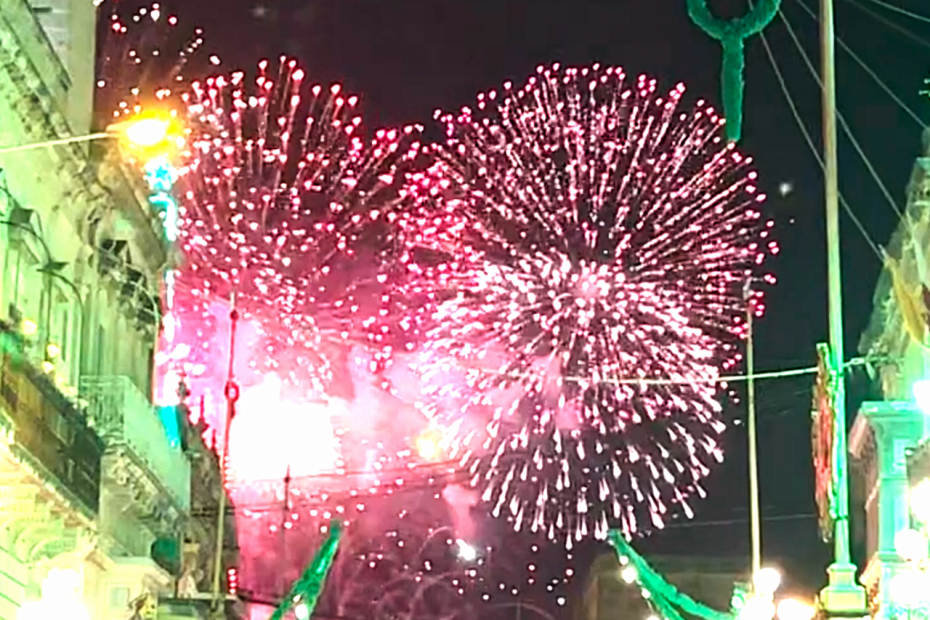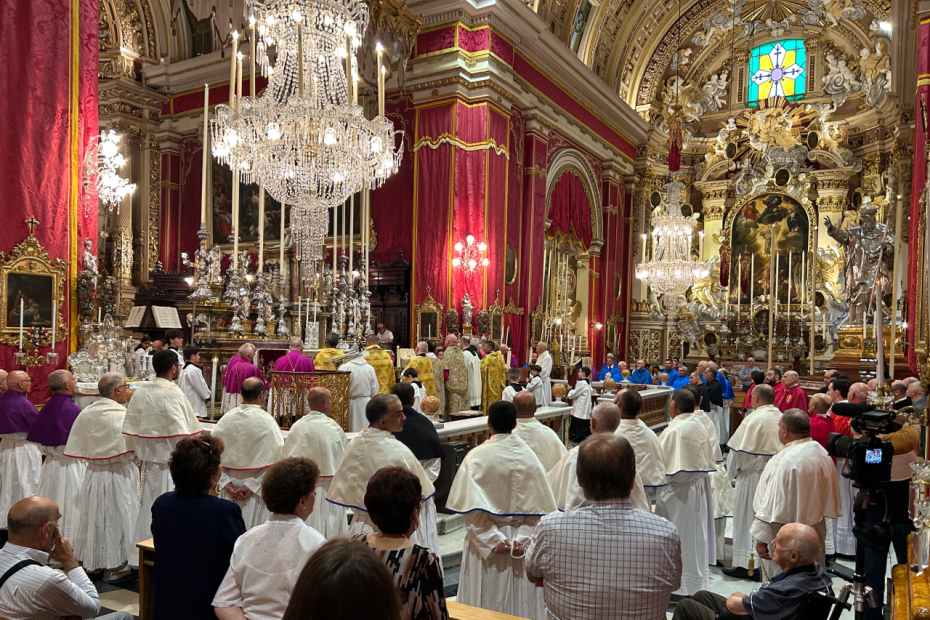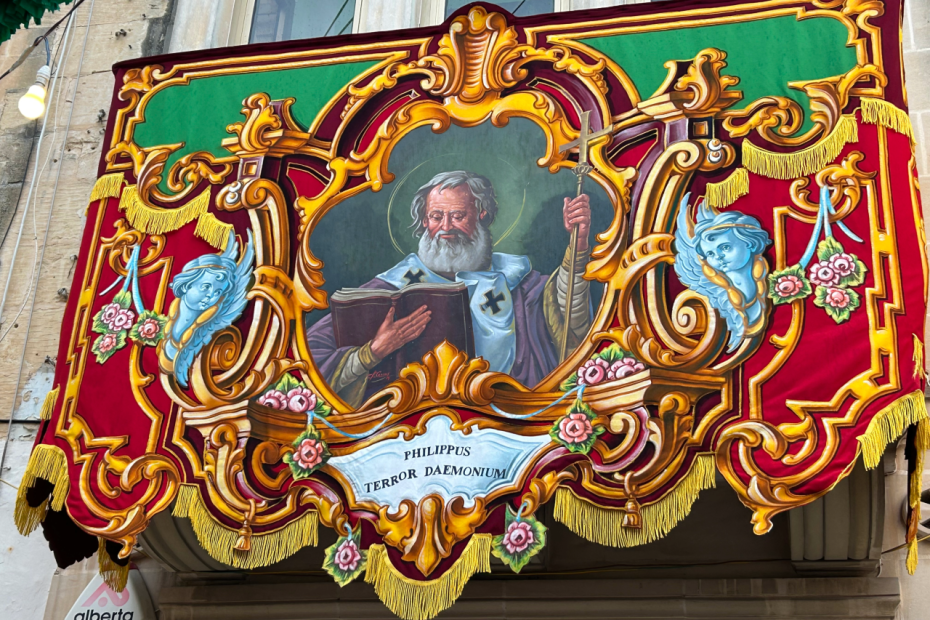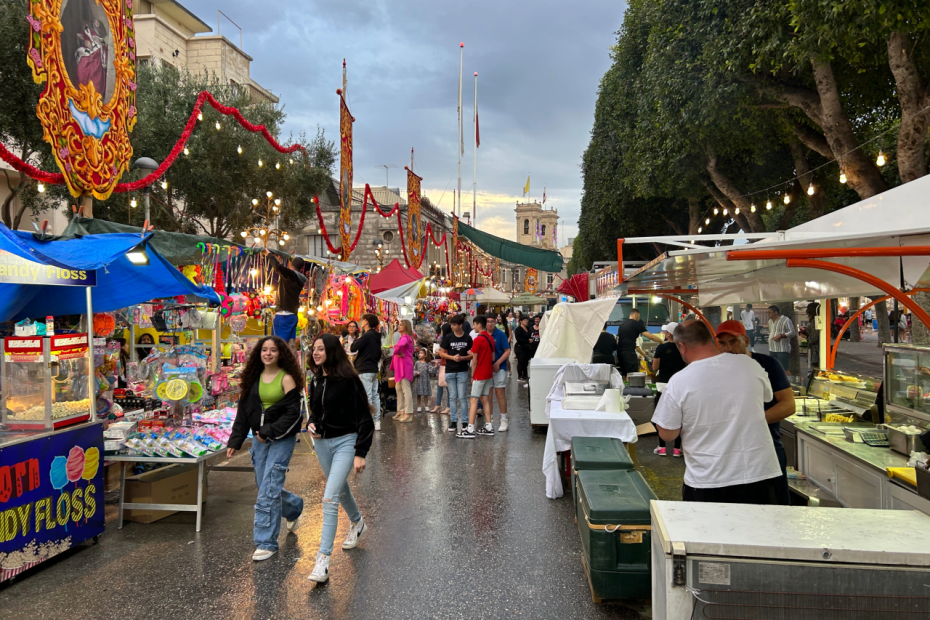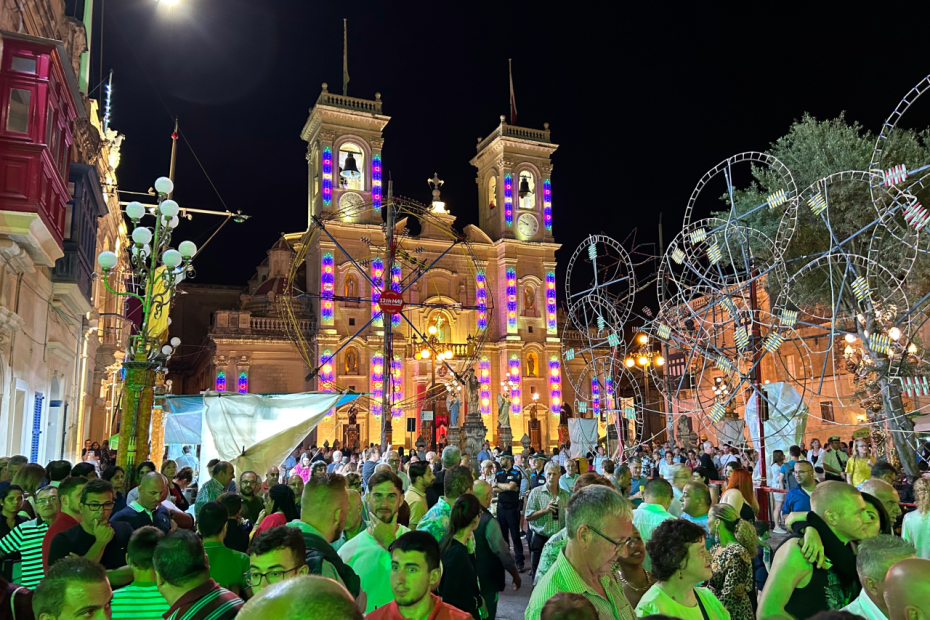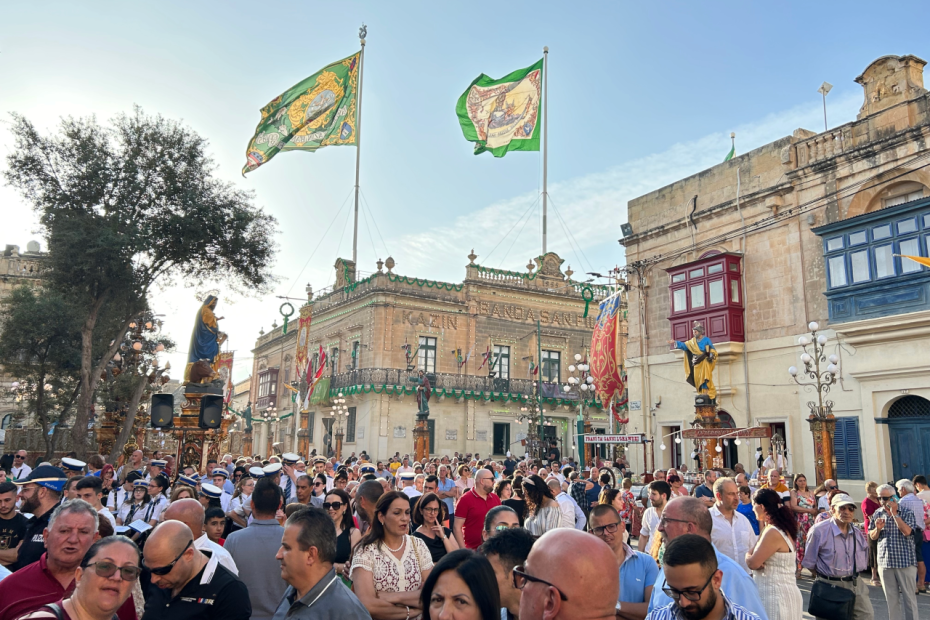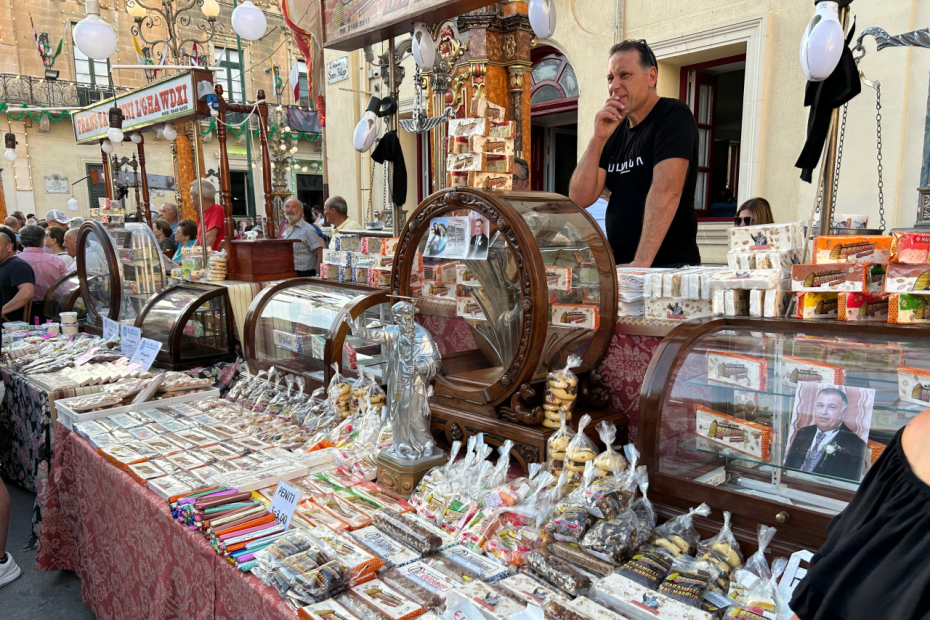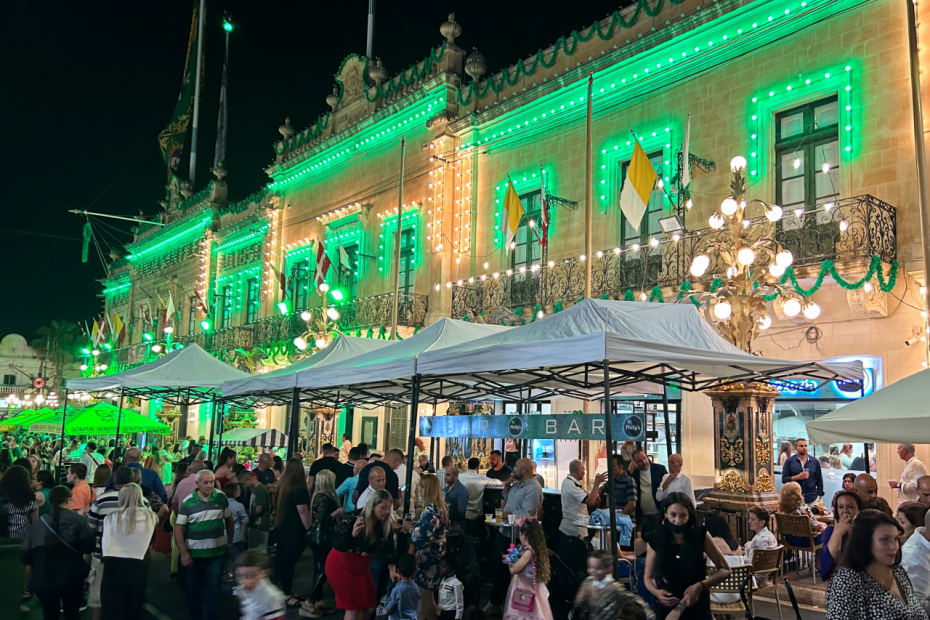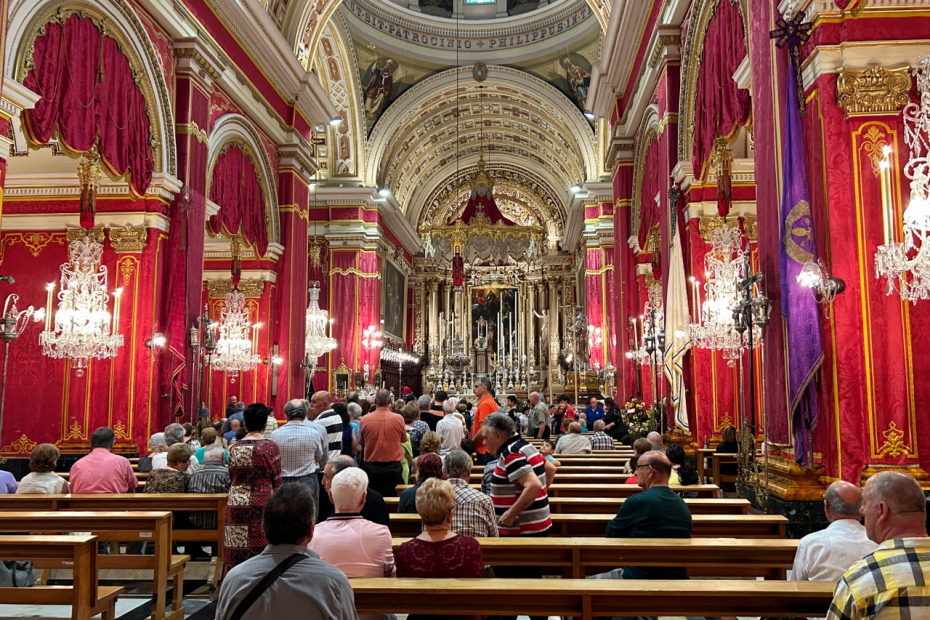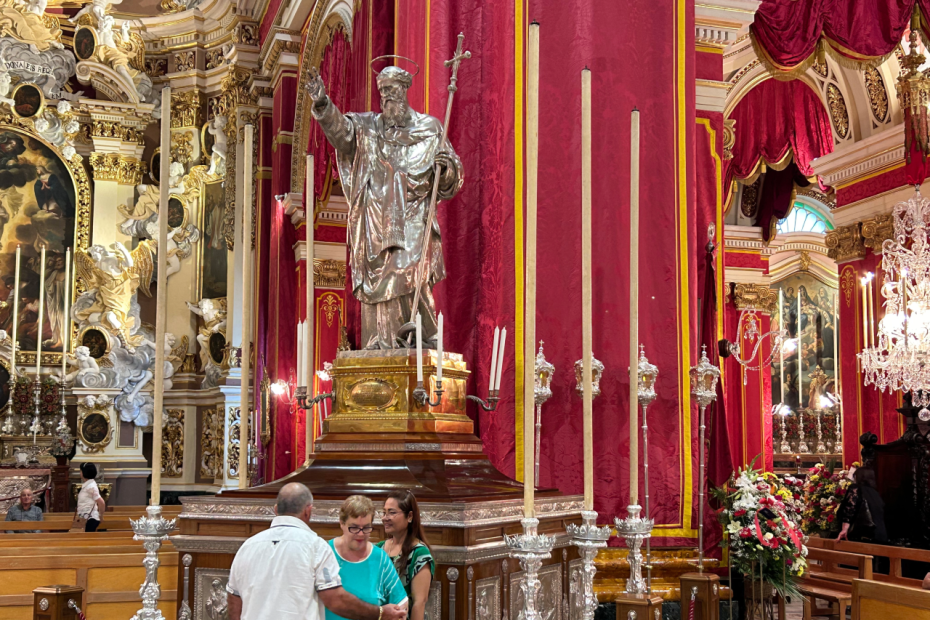In any village in Malta, the summer festa, or feast, is the most spectacular event of the year. More than 100 parish feasts dot the Maltese calendar, concentrated particularly in the summer, even if that means celebrating on a different day than the saint’s liturgical feast day.1 Every parish celebrates its patron saint with a public feast, and many also celebrate another saint in the same manner on a different day.2 One author even describes festa Catholicism as “the dominant, culturally established faith of the Maltese.”3
The festa, a combination of play, processions, food and alcohol consumption, fireworks, and Masses, is a centuries-old tradition in Malta, though it grew into a much larger event beginning in the late 19th century when the band clubs were founded.4 Preparation for the feast takes almost a year and requires a major commitment on the part of many villagers working under the aegis of the parish and band clubs. The clubs jealously guard their roles and responsibilities, and the parish priests sometimes struggle for firmer control over goings-on.5
The aesthetic of the feast, like the design of baroque and neoclassical churches in every village, employs a strategy of superabundance. Streets are festooned with elaborate baroque banners and religious statues; the church is decked out for display; the saint's statue is carried around to be seen; statues of other saints are placed on pedestals dotting the piazza; brass and woodwind bands march and play from bandstands; huge flags flutter in the sky, churches and band clubs are decorated with lights; fireworks fill the sky and the streets for hours; food and drink are plentiful.
Żebbuġ: The Feast of San Filippo in the Church and on the Streets
The feast of San Filippo d’Agira (St. Philip of Agira) in the small city of Żebbuġ (pop. 11,000) serves as a good example for understanding the festa phenomenon. Like most feasts, its organizers do their best to outdo others, though in Żebbuġ two clubs, San Filippo and 12 May (named for the date of San Filippo’s feast on the liturgical calendar) divide responsibility for the San Filippo feast. San Filippo, the oldest band club in Malta, and 12 May, founded soon after, actually started the trend in the 19th century that transformed the feasts into their current form.6
His liturgical feast day notwithstanding, Żebbuġ’s feast of San Filippo d’Agira is celebrated on the second Sunday of June (the parish’s other feast, San Ġużepp, or St. Joseph, is in July). In 2023, as is typical, the feast’s liturgical events began a week before, when the saint’s larger-than-life silver statue was brought out of its niche into the front of the church. Daily Masses were held each of the following days for children, the elderly, immigrants, and participants from local social, cultural, political, and sporting organizations. Homilists sometimes made a point to teach about the life and virtues of San Filippo, a Turkish saint about whom very little is known, except that he is celebrated as the first missionary to Sicily and was a “terrorizer of demons,” named for his powers as an exorcist.
In the days before the feast, the triduum, Żebbuġ was visually transformed. Colorful baroque banners were hung above several streets; lights were strung across the facades of the church and the band clubs; dozens of tall faux-marble pillars were placed in the streets and topped with large statues of saints (including in the food and bar areas); huge feast and band club flags were raised above the clubs. Several houses and balconies were decorated. By Saturday, the main streets in the piazza were closed, and teams of mostly male members of the 12 May club set up the large metal “Catherine wheels” that would spin ablaze with thousands of fireworks later that night. In anticipation of what was to come, amateur fireworks exploded from all directions.
The feast opened on Saturday at 5:30 p.m. with a Mass in San Filippo church, whose interior was hung almost completely in red silk damask that made the crystal chandeliers seem extra bright. Over 200 people, overwhelmingly people over the age of 60, attended. By 6:30, while an orchestra and choir performed sacred music inside, bells rang above and firework explosions boomed outside. It was impossible not to know in Żebbuġ that the feast was beginning. A phalanx of male and female altar servers; male confraternity members in bright blue, red, purple, white, and black vestments; and clergy in Tridentine embroidered vestments processed around the plaza with a relic of San Filippo, returning for devotion at the altar. The church pulled out all the stops from a musical and decorative perspective.
Through the evening, while children played in front of the church and many more people visited the food and alcohol vendors who lined the adjacent promenade, small groups drifted into the church. Some sat in the pews looking toward the altar, often chatting. Others came around and behind the altar to the choir and sacristy to see displays of the church’s treasures, including silver items or Tridentine-style embroidered vestments donated by villagers over generations. Facing the altar, to the side, was the large silver statue of San Filippo, reportedly made generations ago for the equivalent of €500,000. Though there were more than 50 floral sprays lined up in San Filippo’s honor donated by parishioners, most visitors seemed to pay no attention to the saint’s statue at all, except occasionally to pose for pictures in front of it.
The streets were much busier with activity. People lined up at outdoor food stands and bars. Some stands sold traditional treats, but most featured things like burgers and pizza. Families and groups of young people greeted each other. From 9:30 at night–for 15 minutes intensely, and then less so until after 11:15, when they ended with a flourish–the San Filippo Band Club put on a spectacular aerial “Pyro Rhapsody” fireworks display that had taken a year to manufacture in their own fireworks factory on the outskirts of town. (Each association has its own facility, licensed by the government, to manufacture the fireworks). One villager claimed that it included more than 4,000 rockets.
Beginning at 11:30 pm, in the plaza in front of the church and the promenade adjacent, the area around each of more than a dozen tall steel Catherine wheels was sequentially cleared of people by the 12 May Band Club, and the wheel was lit so that the many fireworks attached made it spin in a loud, intense blaze of sparks and light. Paradoxically, the break between two of the Catherine wheels included a loud rendition of the song “Highway to Hell” over the loudspeakers.7
On Sunday, the actual feast day, by the time San Filippo was brought into the streets in procession, the villagers and visitors had been enjoying themselves for a long time. Just before 7:00 PM, the silver San Filippo statue reached the doors of the church on the shoulders of a dozen or so confraternity members, shining in the glow of the setting sun. Church bells peeled, fireworks burst, and many people clapped briefly. An anthem to San Filippo was played and sung and the statue began a long, slow procession through the streets, carried by confraternity members and accompanied by a phalanx of clergy and altar servers. As the statue bobbed deliberately on the shoulders of the men who carried it, its hand, raised in blessing, even appeared to be moving to bless. The ordinary street revelry of the feast continued all around, creating a near cacophony of band music, bells, fireworks, and people enjoying the evening. Eventually, the image returned to the church, a moment that one organizer said was the most emotional point of the feast.
Rivalry, Respect, & Rights
Readers of the foregoing description of the feasts might be tempted to see the feast as a paradigmatic example of religion’s role in uniting a community. After all, villagers devote an extraordinary amount of common energy to organizing the feast. It is hard to even track the number of people who make the feast work–bell ringers, decorators of streets and churches, confraternity members, those who manufacture and set up fireworks, musicians, vendors, visiting priests, police, and cleaners among them. The feast cements religious and civic society, even if that arrangement is occasionally uncomfortable for both sides.
That shared work is required in part because the reputation of the village has long depended on the quality of the feast. Those who visit from other villages judge it comparatively.8 The abundance of fireworks, for example, is not simply a matter of providing enjoyment for the feast goers. It is a way of competing with other villagers and maintaining respect. Generations of villagers have dedicated themselves to manufacturing them at their own fireworks factories despite several explosions over the years that have claimed multiple lives.9
Asked about inter-village rivalry expressed through the San Filippo feast, though, a young woman at the Żebbuġ feast downplayed the significance of it. However, she grew wide-eyed as she characterized the depth of intra-village rivalry between each club’s partisans. She would only characterize the rivalry, though, withholding specific examples from her village. But other people readily described examples from other villages.
Competition between band clubs is almost always a matter of rights and primacy: over which parts of the feast a club is responsible for, or at what point in a procession it marches. More often than not, these responsibilities are considered not simply as volunteer opportunities, but as inviolable rights not to be disrespected.10 A secondary feast should not be allowed to outshine the feast of the patron of the parish, the first feast’s partisans would claim. This is true not only because it is the patron feast, but the older feast. Competing band clubs locate their clubs in some of the prime spots of village piazzas, competing to be as elaborately decorated as their competition. In Żebbuġ, San Filippo d'Agira is similarly located on a massive plot of prime real estate across from the church. It prominently highlights its year of founding, 1851, as the basis of its seniority and status. Nearby, two prominent but less imposing spots are occupied by the other band clubs.
Names can even be seen as an element of competition. Naxxar, where this site’s Holy Week research is centered, has only one feast, but two bands. The older one, in a prominent building on the square fronting the parish church, is named “Peace.” The newer one, just down the street in a less prominent location, is called “Victory.”11
Sometimes the rivalry stretches further into the realm of disrespect, even toward the saints being honored at the feast. One man recounted a time when partisans of the feast of Our Lady of Carmel swore at the rival’s statue of St. Catherine when it passed. Another reported that at the feast of St. Lawrence, the early Christian martyr who was tortured to death on a grill, members of another club shouted, “St. Lawrence, St. Lawrence, barbecue St. Lawrence.” He also recounted an incident of one band club trying to break into another’s when it passed by with its statue, while the other club fought to keep them out. Two others referred to incidents of street fights. More than a generation ago, Jeremy Boissevain recalled an example where there were skirmishes sparked by “bands of girls who hoarsely shout themselves into a frenzy proclaiming the virtues of their saint and the shortcomings of their rivals.” But even then, these were out of sight: “There are no visitors during this part of the feast.”12
The incongruities of the feast were obvious to a great many of the Maltese interviewed for this research, but their preferred solutions were a matter of changing by degree, not somehow limiting the feast to a “purely” sacred event. Clergy work to shape the feast to their preferences. Forbidding the feast has been employed only as a threat, not a goal. And villagers push back. If there are two feasts in a parish, a priest said he can be afraid that he might put up lights on the church that are perceived as brighter for one group than another. The parishioners, one priest reported, just tell him, “No, we decide what goes on here.”
The extreme examples are intermittent at best. Feasts are normally family-friendly, safe places to be. If this sounds like a violent society, one should remember that crime in Malta is quite low compared to other countries. But occasionally they result in the Church needing to mediate or even threatening to cancel the feast. In 2002, the Church issued rules to limit excesses.13 Other examples are more mundane: where there are two feasts, devotees of the alternate feast may simply leave town.
Why division and rivalry are so endemic is another question. In any locale, particular triggers are sometimes named as having initiated the competition. They vary from village to village. But the fact is that some pattern of division pops up repeatedly, despite different anecdotal triggers. Neither is the rivalry new. Scandalous actions due to rivalry were part of the golden age of Catholic religiosity in Malta. In Żebbuġ, competition seems to have been baked in from the beginning. Within six months after the first band club in Malta was founded there, a competing one was founded, and yet another after that.14 Boissevain reviews several potential causes for band club and feast rivalry, including questions of class and social status or politics, but none of those hypotheses bears out.15
The divisions occasionally split families, and they have enduring power. Edward Warrington, among others, describes such competitiveness as an enduring and fundamental characteristic of Maltese life which manifests at the feasts and many other spheres of life.16 An interviewee summarized it this way: “We are a country of two tribes. Always.” Perhaps it is easiest to leave the matter where one man, a daily volunteer at his parish and with a Franciscan refugee food bank, left it when he explained why rivalry is such a part of Maltese life: “It’s more fun that way, isn’t it? You’ve got to do better than the other half.”17
The Religious Meanings of the Feast
It is surely a head-spinning exercise to try to differentiate what is “sacred” and “secular” in the feast, though many readers will likely find elements that they believe are incongruous or incidental to a religious event. But in few other countries could one see people strolling with cotton candy or a beer under banners of an exorcist-saint, with all the elements on this big stage set both brought together for the same occasion. In Malta, where village and parish are coterminous, this is a religious and civic event seemingly inexorably interwoven together.18 A function of a procession is to bring the sacred out of the church and into the street to make the public space sacred, and wherever the supposedly profane elements of the street are at the feast, the effect is an intermingling of sacred and profane.
Oddly, scholarly literature about the festa largely bypasses a fundamental religious question. If the feast is in honor of the saint, who is the saint to the people who put so much energy into the feast? What does he or she mean to them?
He or she is the “patron” of the parish/village, certainly–whatever that means. One context for understanding “patron” saints historically is that they arose in a context where people needed political patrons to approach powerful leaders on their behalf, and sought the same help through saints in the heavenly court. “Patron” also implies a protector role. Several clues point to this linkage to political and social patronage, historically.19 Yet no one I spoke to in Żebbuġ saw their patron saint in any way as a protector, a person who was supposed to look after the village’s needs and protect it from harm. The motto given to San Filippo d’Agira, placed in silver letters on the platform that carried him and on baroque banners in town, “Terror Demonium,” would certainly suggest that he was originally appealed to as a saint powerful enough to scare away the forces of evil.
At the feast in Żebbuġ, the streets were full of religious banners about San Filippo, who occasioned the feast and whose bigger-than-life silver statue would be processed through the streets in blessing. Paradoxically, though, he seemed not to inspire devotion. Inside the church, people often looked at the statue or took a selfie in front of it. Dozens of floral arrangements had been given and placed nearby. Yet no one seemed to pray to him. It was not clear in interviews that anyone did. Asked at the feast whether people prayed to San Filippo, or thought of him as a protector-patron of the village, or a role model or a figure who could secure miracles, one man in his twenties, a self-described weekly Mass-goer, grinned at the question: “No one prays to the saint. He’s not for that. He’s more like the town hero.”
Another man, speaking broadly about the feast phenomenon and the attachment people felt to their patron saint, echoed, “They will fight for their saint…There is a parish church with one feast dedicated to Our Lady, and another feast dedicated to St. Joseph, and they fight between them. It’s just identity.”
A priest from outside of Żebbuġ who thought that the feasts were more a distraction than of significant Christian value said that the patrons of feasts were ultimately most comparable to team mascots.20 Indeed, to Catholics who want to see attention devoted to Jesus and God the Father, a diminution of devotion to patron saints can be a good thing. One such person, in his sixties, claimed that the beliefs of many villagers a generation or more ago were more pantheistic than trinitarian. Still, an interviewee in Naxxar lamented, “In this village, everyone will come out to celebrate its feast for Holy Mary on September 8. But they won’t think about what it means to live like Mary.” Some people complained that today, some people drink too much to be able to participate in the formal religious elements in the early evening. Yet this is not a new development. In the deeply religious 1960s, it was reported that the feast “sometimes degenerates into a drunken spree.”21 At the Żebbuġ feast, the difference between attendance rates at the liturgical and non-liturgical parts of the feast was attributable to choice, not public drunkenness. But then again, at an event where the streets were saturated with religious images and the very occasion is religiously framed, it makes little sense to divide the festa into simple sacred and secular spheres.
It is commonplace to say in Malta that the feast, among other things, is growing less religious and society more secularized. But by all accounts, while other measures of religiosity are diminished, the scale of the feasts has only grown in recent decades. Already in the 1990s, Carmel Tabone, O.P. suggested that whereas once there were so many aspects where “there was little separation between the social and the religious, by the 1990s the festa remained a primary manifestation of the relationship between Church and society that shaped Maltese culture."22 At a time when the foundations of Maltese cultural identity are less certain than ever, the feasts are regarded, likely as much as ever, as integral to Maltese culture and Maltese Catholicism.
- 1Most public feasts are celebrated on a Sunday, so they rarely coincide with the actual feast day.
- 2A number of village feasts are dedicated not to a saint, but to the Holy Trinity, Christ our Savior, the Holy Cross, the Sacred Heart, or Jesus of Nazareth.
- 3Ray Debono-Roberts, “Festa-Catholicism and Media Religion: The Reproduction and Transformation of the Festa in Malta,” History & Anthropology 14, no.4 (2003): 384, doi:10.1080/027520032000156497.
- 4Debono-Roberts, “Festa-Catholicism and Media Religion,” 386-387.
- 5As noted elsewhere on this site, band clubs are also important for the Holy Week processions and are generally among the most important social venues in the village.
- 6On the founding of band clubs and how they transformed the celebration of the parish feast, see Jeremy Boissevain, “Festa Partiti and the British: Exploding a Myth,” in The British Colonial Experience 1800-1964: the Impact on Maltese Society, ed. Victor Mallia-Milanes (Malta: Mireva Publications, 1988), 214-229. Boissevain claims an 1860 starting date for the San Filippo band, which dates itself to 1851, a year prominently displayed on its headquarters.
- 7The choice was not spontaneous. Variations of it could be heard from the San Filippo Band building during Saturday’s setup.
- 8Anthropologist Jeremy Boissevain, who devoted three books to Maltese culture, placed heavy emphasis on the feast. This article depends in significant part on his work, insofar as it was validated by interviewees to be relevant to the current situation. See Saints and Fireworks: Religion and Politics in Rural Malta (London, Athlone, and New York: Humanities Press, 1965); Hal Farrug: A Village in Malta (New York: Holt Rinehart and Winston, 1969); and his chapter, “Factions, Parties and Politics in a Maltese Village,” in his final collection, Factions, Friends and Feasts: Anthropological Perspectives on the Mediterranean (Oxford and New York: Berghan Books, 2013), 28-41. As the final title makes clear, Boissevain grappled considerably with the themes of unity and division in the feast and elsewhere in society.
- 9In Żebbuġ, which has three fireworks factories, one for each band, an explosion in 1955 killed four villagers, and another in 1992 killed one villager. The factories are more intensely regulated and licensed today.
- 10These rights were similarly a part of Holy Week processions. A band club leader told me that it had a contract with the parish delineating when it marched in the Good Friday procession, so that no future priest could abrogate it. Boissevain (Hal Farrug, 74) describes those matters “as part of the cultural property of each confraternity.”
- 11Both are Marian references. The first is to Our Lady of Peace. The second is to Our Lady of Victories, commemorating the victory of the Knights of Malta over the Turks in the Great Siege of 1565.
- 12Boissevain, Hal Farrug, 71.
- 13Debono-Roberts, “Festa-Catholicism and Media Religion,” 389-391.
- 14The dates above derive from Boissevain’s research. As noted, the bands claim slightly different foundation dates. “By 1890, twelve of the twenty two villages and towns in which band clubs were established were divided by rival bands.” Boissevain, “Festa Partiti and the British: Exploding a Myth,” 218.
- 15Boissevain, “Factions, Parties and Politics in a Maltese Village,” 1275-1287.
- 16Personal conversation. Warrington is Associate Professor of Public Policy at the University of Malta and an astute writer and commentator on Catholic matters there.
- 17Interviewees said that there were similarly few differences between the two parties, but that people had fierce loyalties to one or the other parties as a matter of identity.
- 18The patron in the feast, Boissevain reminded us, is “patron of both village and parish.” Hal Farrug, 61.
- 19Boissevain linked the feasts directly to a patronage system in Maltese culture. He points out, “the word for patron in Maltese is ‘saint’ (qaddis).” Boissevain, Saints and Fireworks, 120-122. Warrington, in a personal conversation, points to the same phenomenon: there was no real local government in the villages aside from the parishes. Decisions were made in the capital, and patrons helped bridge the distance.
- 20Students of Emile Durkheim, a founder of Anthropology and Sociology, will also find the emphasis on the parish saint in the feast, or on competing saints among competing band groups, to be one of the clearest and most interesting examples of a totem in Catholicism today. But they should also find Emile Durkheim’s accompanying notion of the sacred and the profane as completely distinct spheres to be not so simplifiable in a traditional Maltese context.
- 21Boissevain, Saints and Fireworks, 60.
- 22Carmel Tabone, O.P., Maltese Families in Transition: A Sociological Investigation (Santa Venera, Malta: Ministry of Social Development, 1995), 49.
